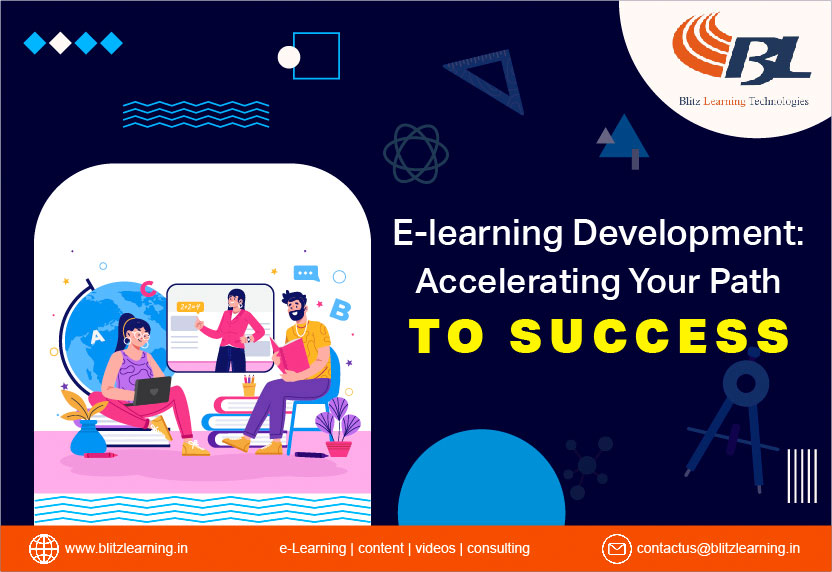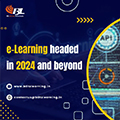
Blog
- Home
- Blog

30Aug
Efficient eLearning development: accelerating your path to success
Introduction
In today’s fast-paced world, where information is constantly evolving, businesses and educational institutions need to keep up with the demand for rapid and effective learning solutions. Enter eLearning – a dynamic approach to education that leverages technology to deliver knowledge and skills efficiently. However, the effectiveness of eLearning hinges on its development process. Efficient eLearning development not only saves time and resources but also ensures that learners receive high-quality content that drives success. Let’s explore strategies to accelerate your path to eLearning success.
Clear learning objectives
Before embarking on eLearning content development, define clear learning objectives. What skills or knowledge do you want learners to acquire? Well-defined objectives guide eLearning content creation, ensuring that every element aligns with the learning goals. This focus prevents unnecessary tangents and keeps the eLearning module concise and effective.
Agile development
Embrace an agile development approach. Rather than developing the entire eLearning content and module at once, break it into smaller components or modules. This allows for iterative development, quick adjustments based on feedback, and the flexibility to make changes as needed.
Rapid authoring tools
Leverage rapid authoring tools that streamline the development process. These tools offer templates, interactions, and multimedia integration, reducing the need for extensive coding and design work. They enable subject matter experts and instructional designers to collaborate seamlessly, expediting content creation.
Collaborative development
Effective content development and eLearning development involves collaboration among various stakeholders – subject matter experts, instructional designers, graphic designers, and tech experts. Regular meetings and open communication ensure that everyone is on the same page, minimizing misunderstandings and rework.
Reuse and repurpose
Maximize efficiency by reusing and repurposing existing content. If you have relevant materials from previous training sessions or resources, adapt and integrate them into your eLearning modules. This approach not only saves time but also maintains consistency across your learning materials.
Multimedia integration
Engagement is key to effective eLearning. Incorporate multimedia elements – videos, animations, infographics, and audio – to make the content visually appealing and interactive. Well-designed multimedia not only captures attention but also enhances understanding and retention.
User-Centric design
Put the learner at the center of the design process. Consider their preferences, learning styles, and technological comfort. A user-centric design ensures that the eLearning module is intuitive, easy to navigate, and responsive across different devices.
Assessment strategies
Integrate meaningful assessments to gauge learners’ comprehension. Instead of relying solely on traditional quizzes, incorporate scenario-based assessments, interactive simulations, and practical exercises that mirror real-world situations.
Pilot testing
Before launching the eLearning module to a wider audience, conduct pilot testing with a small group of learners. Gather feedback on usability, content clarity, and overall effectiveness. This feedback loop allows for improvements and refinements before the official launch.
Continuous improvement
eLearning development doesn’t end with the launch. Regularly review and update your content based on learner feedback, changes in industry trends, or emerging technologies. This commitment to continuous improvement ensures that your eLearning modules stay relevant and effective over time.
Gamification and interactivity
Enhance engagement by integrating gamification elements such as badges, leaderboards, and challenges. Interactive scenarios and branching scenarios allow learners to apply concepts in practical contexts, boosting retention and application.
Conclusion
Efficient eLearning development is a balance between well-defined objectives, agile processes, collaborative efforts, and learner-centric design. By leveraging rapid authoring tools, multimedia integration, and data analytics, organizations can create effective eLearning modules that accelerate learning and drive success. Remember that the key to efficient eLearning development is not only delivering content quickly but also ensuring that the content is of high quality, engaging, and aligned with the learners’ needs. With these strategies in place, you can create a powerful eLearning experience that propels learners towards their goals.

Neha Tyagi
About authorAs a Digital Tech professional with significant experience, Neha Tyagi has mastered the art of teamwork. Throughout her career, she maintains a commitment to continuous learning. Currently, Neha is delving into innovative technologies aimed at transforming businesses.



Leave a comments